8 lessons to learn from a herb garden gone wild
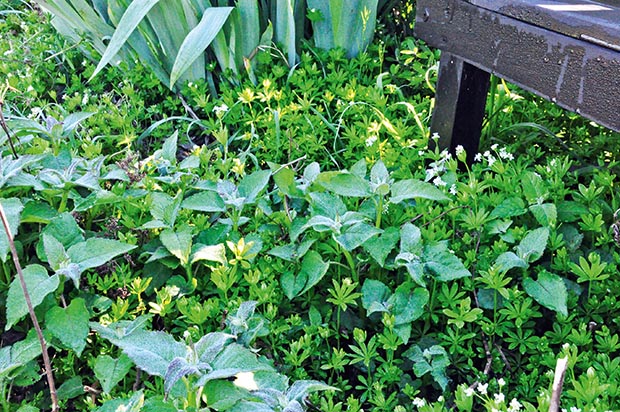
Bergamot and sweet woodruff fight for space.
Five years after planting her herb garden, Jenny’s plants have forgotten who is boss.
Words: Jenny Somervell
The sneaky origanums have escaped from behind their tidy brick edging and have launched a frontal assault on the lavender and tarragon beds. The sweet woodruff is not behaving very sweetly at all towards the neighbouring groundcovers and is clearly poised for a complete takeover.
The carpeting thymes have given up the fight with clover in the beds where they were planted and done a runner onto the paths instead. I feel betrayed. None of the books I read have ever spelt out how badly mannered some of these plants can be. I admit I have been dubbed a catastrophiser, and no doubt this mess can be sorted.
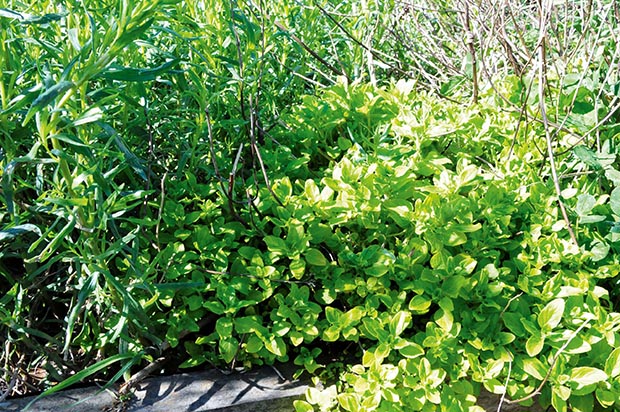
Golden oregano invading the tarragon.
Also, if I am honest, I have some responsibility. Times change, life gets busier, the limbs that were once lithe are now more reluctant to bend and pull. Supping lattes with friends seems much more attractive.
I remember my landscape designer warning me that I wouldn’t always want to work in the garden and would I consider something smaller? Alas, I did not, and now she is proved right but I just didn’t expect it to be so soon, just five years after it was planted. It is time for a revamp.
STRUCTURE SAVES THE DAY
One thing I don’t regret is taking the time to design a well-structured garden. Structure consists of hard landscaping, in our case timber-edged raised beds, brick paving, and permanent, evergreen and deciduous herbal shrubs. These are especially important in the herb garden because it’s largely dormant in winter.
The garden structure took a lot of time and effort to create but the benefit is we don’t have to redesign it. We can simply replace plants that aren’t working with ones that will co-operate and preferably be lower maintenance. But are there low maintenance herbs?
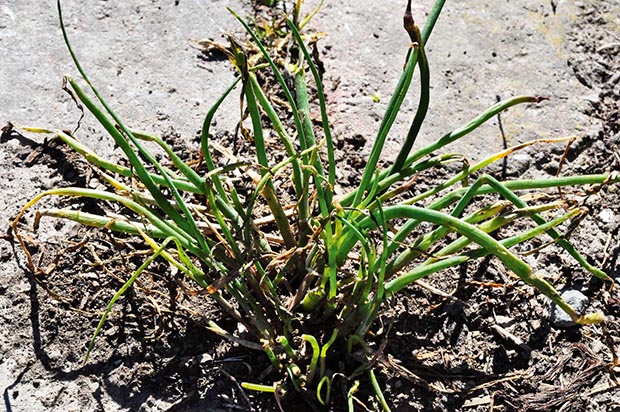
Chives where they shouldn’t be.
Most herbs require some form of maintenance such as cutting back after flowering and/or lifting to divide every three years or so to maintain vigour, the sort of back-breaking labour I now try to avoid. The majority are also winter dormant, so to avoid a rash of weeds in the autumn and spring, mulching is required.
ONE TIP ABOUT HEDGING PLANTS THAT WILL SAVE YOU MONEY
One of our big problems is the hedging plants we chose to use. The Corokia hedge has died out in places where it has been shaded by taller plants, which some of our medicinal herbs are. Hindsight is a great thing but we might have been better off with a hedge of traditional bay or myrtle. Take special care when choosing hedging species – they are difficult and expensive to replace.
HERBS THAT HAVE TO GO
The highest maintenance herbs in my garden are the carpeting thymes. They look gorgeous in summer with bees buzzing over them but their tiny leaves mean there are too many spaces for weeds to grow and not enough space to mulch between them.
They’re pesky little things and I have decided to do away with them, much to the disappointment of the bees. Perhaps I can make a brick area somewhere just for them, since they seem to prefer bricks to soil. Coming up with a mat-forming, evergreen replacement that is at least vaguely herbal is more difficult.
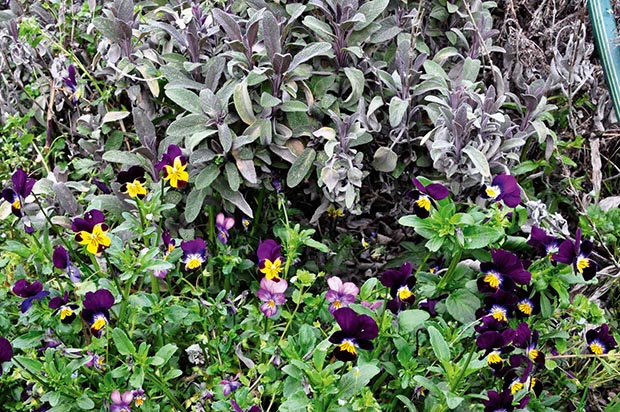
Heartsease (Viola tricolour) invades the red sage.
The best I can think of is New Zealand daphne (Pimelia prostrata), a scented native groundcover. Prostrate rosemary could work too, but if you have any better ideas do let me know!
As for the ornamental origanums, the bees love them but that’s all. Unless we can eat a herb, my husband is not interested in it, and I’ve finally realised there is a much better chance of enlisting his help if it is a vegetable or fruit, so with this in mind I have ordered a bunch of colourful vegetables.
REBEL HERBS THAT HAVE TO STAY
Some of our problem herbs lack space or are in the wrong place. Herbs that want to roam will roam. The sweet woodruff quickly outgrew its allotted square metre and is now invading the chamomile lawn but it will be just fine roaming under the shrubs in our more informal, woodland garden.
Another herb that took me by surprise was the not-so-mild-mannered bergamot. Bergamot may be beautiful, but it carries the twin swords of being shallow-rooted and quick-spreading, at least in our light soils. Without regular division the roots quickly become congested resulting in dry, hungry, weak shoots and unhealthy, mildew-covered leaves.
It is also better off with some summer shade and organic mulch. Then there are the sneaky self-seeders. Every year I think I will take the flower heads off the fennel before seeding and every year I forget. The result is a fennel forest. As for the promiscuous chives, no-one warned me they would march up the pathways with their long, inextricable roots.
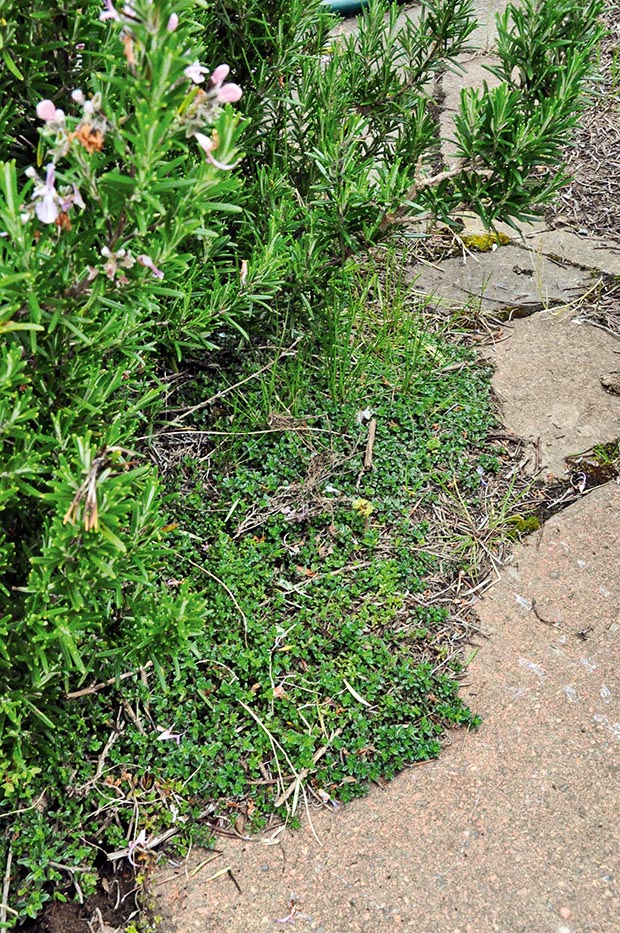
Creeping thyme creeps.
Lest this all sound rather negative, let me say for the record that I love my herb garden. I love the bees and the life in summer, the gorgeous scents and colours and even the wildness – in moderation. But taming a herb garden is a bit like developing an animal herd – you have to constrain or cull the wild beasts.
8 LESSONS I LEARNED FROM MY HERB GARDEN
Your garden is your teacher, so what can we learn from my rebellious plot?
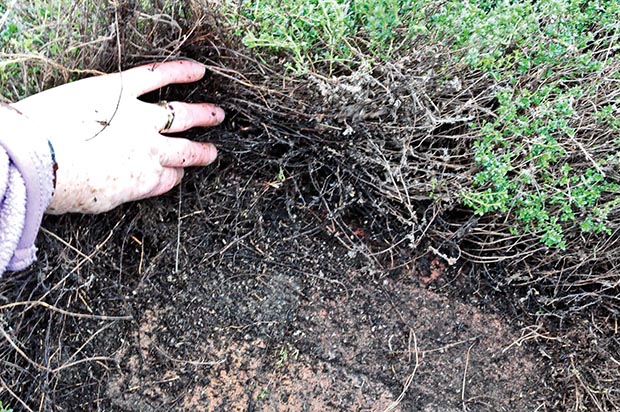
1. Invest in permanent structure
Hard landscaped paths, garden edges, hedges and raised beds are worth the investment for time saved in maintenance later. Permanent evergreen and deciduous plants such as box, bay, rosemary, myrtle, lemon verbena, fruit trees, roses and hedging help constrain the garden, keep it tidy and provide structure in winter when herbaceous perennials die down.
2. Think ahead
How will your garden fit into your life in five years time? How much time/energy will you have then?
3. Recognise your limitations
How much time do you want to spend, and can you spend, on garden maintenance? Does a weedy garden really bug you? Try to be realistic.
4. Be a selective gardener
Be very choosy about the plants you select. Do you really need them? Are they plants worth weeding? Will you still be happy to weed them in five years time?
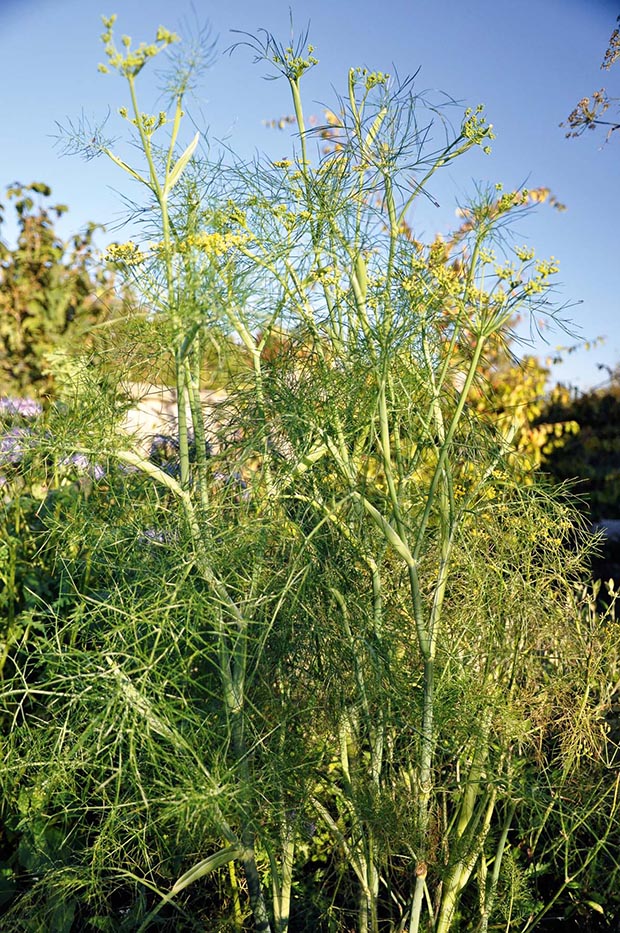
Fennel is a prolific self-seeder.
5. Check the aggressive tendencies of plants
Do they have creeping rhizomes? Will they self-seed heavily? Can you place the aggressive plants where they cannot invade other species, for example in a bottomless bucket, in-ground sink or tub?
6. Try to source growing descriptions from New Zealand plant references
I have been caught out on this! English herb references give lower height and space requirements than most plants grow to in our climate as the UK gets far less sun compared to NZ.
7. Can you provide the conditions plants need?
If a plant needs one metre square it is going to try to take it, whether you allow it or not. Plants needing a well-drained soil such as the Mediterranean herbs (oreganum, lavender, rosemary, thyme, sage) will be more prone to competition from weeds if they have to struggle in a wet, heavy soil. Conversely, in a light soil they will be more vigorous.
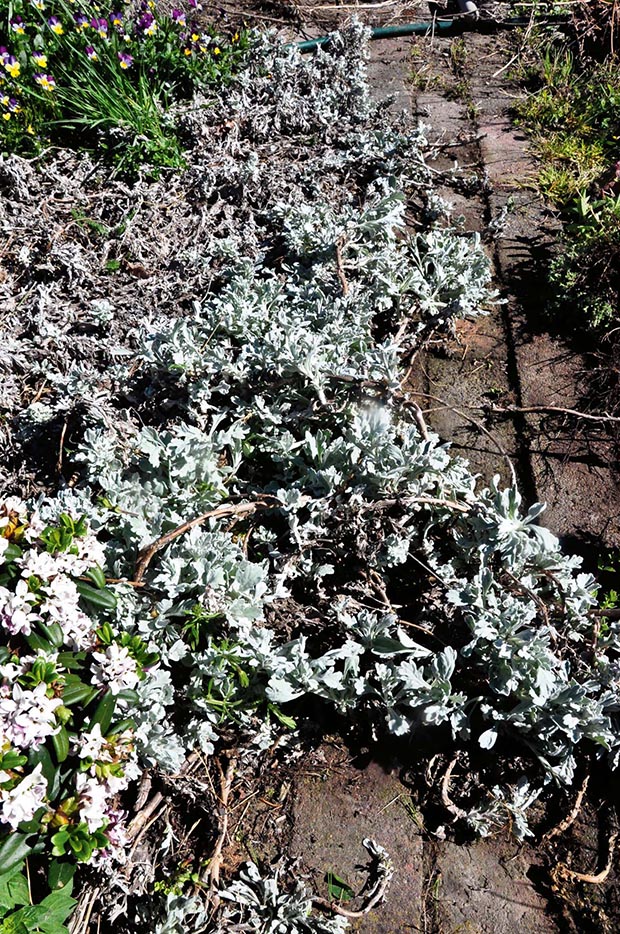
Creeping wormwood (Artemisia stellariana).
8. Get mulch on before the weeds grow
Decide what sort of mulch will work. If you don’t make it, order it so it is ready. The twiggy mulch we produce in our garden chipper provides good aeration and breaks down slowly.
Pea straw is readily available but breaks down faster and encourages slugs. It can also seed peas and create more moisture than Mediterranean herbs like. Sawdust can be obtained cheaply or free but has a high carbon-to-nitrogen ratio so it depletes the soil unless nitrogen is incorporated.
HERBS TO BEWARE OF TAKEOVER POTENTIAL
• Creeping wormwood, eg Roman wormwood, Artemisia pontica
• Mints, Mentha sp*
• Yarrows, Achillea millefolium*
• Sweet woodruff, Asperula odorata
• Soapwort, Saponaria officinalis
• Creeping germander, Teucrium chamaedrys
• Lady’s bedstraw, Galium verum
• Tansy, Tanacetum vulgare*
• Horseradish, Cochlearia amoracia*
• Comfrey, Symphytum sp*
• Bugle, Ajuga reptans
• Lemon balm, Melissa officinalis*
• Perennial rocket, Eruca sylvatica*
*grow in separate areas or containers
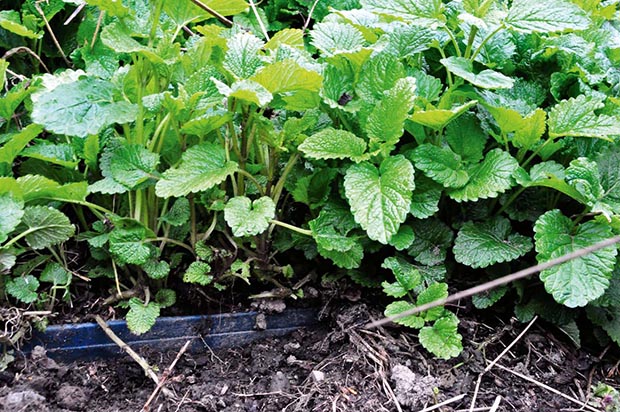
Lemon balm escaping.
VIGOROUS, CLUMP-GROWING HERBS WHICH NEED REGULAR DIVISION AND SPACE TO MOVE
• Bergamot, Monarda sp
• Costmary, Chrysanthemum balsamita
• Some Salvias, eg S. uliginosa, S. Argentine Skies
NATIONAL PLANT PEST ACCORD LIST: PROHIBITED INVASIVE HERBS WHICH ARE BANNED FROM SALE, PROPAGATION AND DISTRIBUTION
• Yellow flag iris, Iris pseudocorus
• Purple loosestrife, Lythrum salicaria
• Horsetail, Equisetum sp
HERBS WITH SELF-SEEDING POTENTIAL
• Fennel, Foeniculum vulgare
• Agrimony, Agrimonia eupatoria
• Calendula, C. officinalis
• Heartsease, Viola tricolour
• Jacob’s ladder, Polemonium coeruleum
• Comfrey, Symphytum sp
• Foxglove, Digitalis purpurea
• Mullein, Verbascum sp
• Catmint, Netpeta faassenii
• Chives, Allium schoenoprasum
• Sorrel, Rumex sp
• Herb Robert, Geranium robertianum
• Red-leaved plantain, P. latifolia atropurpurea
• Epazote, Chenopodium ambrosioides
HIGH MAINTENANCE HERBS WHICH DON’T COMPETE WELL WITH WEEDS
• Carpeting thymes, Thymus serpyllum
• Dianthus
• Chamomile, Matricaria chamomilla
• Origanum sp
• Lawn chamomile, Chamaemelum nobile
• Saffron, Crocus sativus
• Allium sp
HEDGING PLANTS THAT WILL TOLERATE SOME SHADING
Choose carefully, and if hedging plants require full sun (eg corokia, rosemary, lavender) be careful that large herbs don’t shade them.
• Bay, Laurus nobilis
• Myrtle, Myrtus communis
• Box, Buxus sp
• Holly, Ilex sp
• Silver germander, Teucrium frutecans
Love this story? Subscribe now!
 This article first appeared in NZ Lifestyle Block Magazine.
This article first appeared in NZ Lifestyle Block Magazine.
